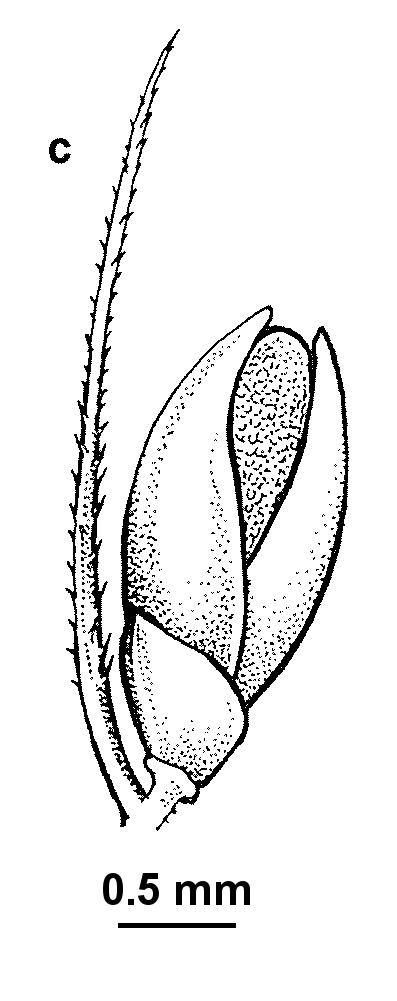Setaria viridis
(L.) P.Beauv. Green Pigeon-grassTufted annual. Culms erect or geniculate at base, to c. 70 cm high. Leaves glabrous; blade flat, scabrous, to 30 cm long and 10 mm wide; ligule 1–2 mm long. Panicle cylindrical, 1–10 cm long, sometimes interrupted near base, branches to 10 mm long, or not developed. Spikelets blunt, 1.7–3 mm long, each subtended by 1–3 antrorsely barbed bristles, 5–10 mm long; lower glume 1–3-nerved, ovate, from one-quarter to one-third as long as spikelet; upper glume 5–7-nerved, elliptic, obtuse, sub-equal or equal to spikelet; lower floret neuter, its lemma equal to spikelet, its palea rudimentary to half as long as lemma; fertile lemma obtuse, equal to spikelet, dorsally rounded, granular, sometimes obscurely transversely ridged Flowers Feb.–Jun.
Wim, GleP, VVP, VRiv, GipP, OtP, Gold, CVU, GGr, DunT, NIS, EGL, EGU, HSF, HNF, Strz. Naturalized in all States except NT, widely introduced. Native to warmer Northern Hemisphere countries. Apparently uncommon in Victoria, most records derive from pre-1950 collections, mostly from Gippsland (e.g. Newry, Stratford, Murrungower), with more recent collections from e.g. Donald, Werribee and near Zumsteins in the Grampians.
Although generally treated as distinct from S. verticillata, the only feature separating the two species (i.e. antrorsely or retrorsely barbed bristles) seems a rather trivial attribute on which to maintain a specific distinction. Some treatments refer to S. verticillata having a hispidulous inflorescence axis and S. viridis a pilose to villous one, but the occurrence of apparent hybrids, having antrorse bristles and hispidulous axes casts doubt on the utility of this character.
Walsh, N.G. (1994). Poaceae. In: Walsh, N.G.; Entwisle, T.J., Flora of Victoria Vol. 2, Ferns and Allied Plants, Conifers and Monocotyledons, pp. 356–627. Inkata Press, Melbourne.
 Spinning
Spinning


